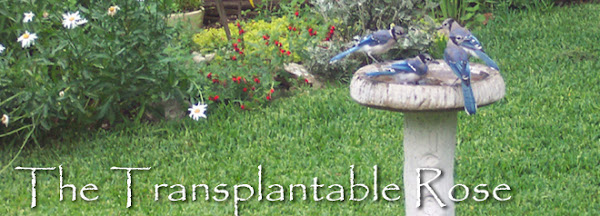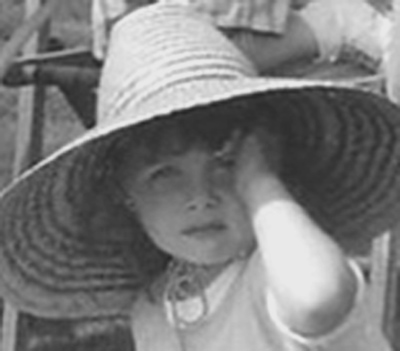Lady Bird always loved the wild flowers
She wanted us to love them, too.
Here in the city where her wildflowers grew,
We bid our Lady Bird adieu.
The flag flies at half-mast for Lady Bird Johnson in a new garden fitted within the footprint where the Arizona Ash used to stand. I planted wildflowers like Eupatorium greggii - Gregg's Mistflower, Anisicanthus wrightii, also called Hummingbird Bush, and a plain old calico-colored Lantana, adding Salvias guaranitica and 'Black & Blue', a 'Bengal Tiger' canna and Verbena bonariensis. They're growing near the birdbath in a mixture of clay, compost and the ground-up stump of the large Ash tree. These plants are just beginning to flower, bringing an occasional butterfly, bee, or hummingbird to see if it's worth stopping here. 
Malvaviscus is another flower planted to please the hummingbirds. It grows in light shade near one of the two remaining Arizona Ash trees and is sometimes called wax mallow or Turk's cap.

More wildflowers - a pink selection of Gaura lindheimerii and Echinacea purpurea 'Purple Stars'.
 These Balloonflowers - probably Platycodon grandiflora - were brought along as seedlings from Illinois; planted in fall of 2004, they're now looking settled in their second Texas home.
These Balloonflowers - probably Platycodon grandiflora - were brought along as seedlings from Illinois; planted in fall of 2004, they're now looking settled in their second Texas home.  Buds and flowers keep appearing on this 'Champagne' mini-rose, which was a mid-winter gift from my mother and sisters.
Buds and flowers keep appearing on this 'Champagne' mini-rose, which was a mid-winter gift from my mother and sisters.
The first Amarcrinum flowers of 2007 opened yesterday. The variety is possibly 'Fred Howard'. If you're interested in amarcrinum, you can read more about it in this older post. Crinum-type lilies are not always fragrant, but this one is!
 The White crepe myrtles, Lagerstroemia 'Acoma', are having a fine summer. They were twisted and curled by too many years in deck containers before we moved here and it's taken several more years to train them into tree-form again - this year they've finally grown taller than the privacy fence.
The White crepe myrtles, Lagerstroemia 'Acoma', are having a fine summer. They were twisted and curled by too many years in deck containers before we moved here and it's taken several more years to train them into tree-form again - this year they've finally grown taller than the privacy fence.
Near the corner of the veranda you can see a Pink crepe myrtle, the boxwood hedge, and hanging baskets with impatiens, ornamental sweet potato vines, oxalis and Evolvulus 'Blue Daze'. I've used only impatiens and torenia in other years, but with the Ash gone, the sun is stronger on this end of the veranda so I'm experimenting with the 'Blue Daze'.
 Our 'Julia Child' rose, bought in early spring, is having a third bloom cycle! She's backed by a white coneflower and Mexican Oregano.
Our 'Julia Child' rose, bought in early spring, is having a third bloom cycle! She's backed by a white coneflower and Mexican Oregano.
The Buddleja 'Black Prince' above right has been in bloom for months; the yellow lantana seems happier now that the weather has turned hot.
 Perovskia - called 'Russian sage' with a true sage in the background, Salvia guaranitica.
Perovskia - called 'Russian sage' with a true sage in the background, Salvia guaranitica. Three cupheas are in bloom now. This orange cuphea is probably Cuphea ignea, also called cigar plant. It dies back in the cold, then grows into a shrub by the end of the summer. It's planted near another chunk of 'Bengal Tiger' canna and one of the the 'Acoma' crepes.
Three cupheas are in bloom now. This orange cuphea is probably Cuphea ignea, also called cigar plant. It dies back in the cold, then grows into a shrub by the end of the summer. It's planted near another chunk of 'Bengal Tiger' canna and one of the the 'Acoma' crepes.
Above is a close-up of the orange cuphea. You can decide for yourself if it looks like a cigar!
 The red and purple flowers of Cuphea llavea, nicknamed Batfaced cuphea, aren't very big, but hummingbirds always find them.
The red and purple flowers of Cuphea llavea, nicknamed Batfaced cuphea, aren't very big, but hummingbirds always find them.
This pink cuphea also has that 'Bat-faced' look, but its growth pattern is more like the orange one - each winter it dies back to a few inches tall. It sits like an undecided lump for a few months, but with sun, warmth and water, decides that Austin is not so bad after all, and by August it's turned into a three-foot tall shrub again, covered in bees and trying to smother its neighbors.
Here's a list of some other plants showing floral action. The sunflower is just starting, plants like the coreopsis are full of buds and blossoms while others like the larkspur are almost done. Dependable workhorse plants like Abelia, Salvias and the honeysuckle have produced flowers month after month.
Abelia
Salvia 'Coral Nymph'
Liriope
Tomatoes
Peppers
Cannas
Coreopsis 'Creme Brulee'
Chrysanthemums
Petunias
Dianthus
Salvia greggii in several colors.
Pavonia lasiopetala, a native Rock Rose
Blue plumbago
Fennel
A few apricot daylilies
Larkspur
Purple leaved oxalis
'Blue River II' hardy Hibiscus
Sunflower
Vitex agnus castus
Coral honeysuckle
'Little Gem' Magnolia
Scuttelaria - skullcap
Zinnia linnearis
Happy Garden Bloggers Bloom Day, organized by Carol of May Dreams Garden.
I hope you're all having a blooming July in your own garden. We're spending time at other gardens this weekend on the annual Austin Pond Society Tour.









